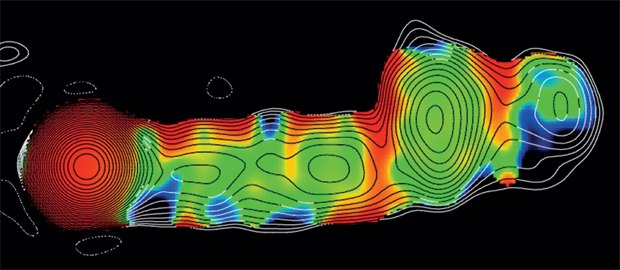Feb 11 2013
Valerie Marchenko ’13 was a competitive figures skater for most of her life before Brandeis. She says it would have been nice to make the cover of Skating Magazine.
 “Spectral index” reveals relative concentrations of high- and lower- energy electrons. Red and yellow areas have more high-energy electrons; green and blue areas show where there are more low energy electrons. Image/Valerie Marchenko
“Spectral index” reveals relative concentrations of high- and lower- energy electrons. Red and yellow areas have more high-energy electrons; green and blue areas show where there are more low energy electrons. Image/Valerie Marchenko
But now her mind is more on stars than skates, and she is very happy to have the image she created of the quasar 3C345 chosen for the cover of this month’s Astronomical Journal, that features an article she co-authored with astrophysics professors David H. Roberts and John F. C. Wardle.
A physics major with minors in creative writing and math, Marchenko has been doing research since her freshman year. This is her second paper in a mainstream astronomical journal. Her first was co-authored with professors Roberts and Wardle and two other Brandeis undergraduates.
Marchenko began studying astrophysics in the beginning of high school. She says her interest doesn’t stem from any event in particular, but rather a general curiosity about the origin of pretty much everything.
The journal cover is the result of many months of imaging the source, which she says is especially interesting due to its unusual twisted polarization structure. Unlike most observed sources, she says, the electric vectors of 3C345 do not lie transverse to the axis of the plasma jet but instead twist by some 30 degrees.
Her data come from the Very Large Array (VLA), which consists of 27 radio antennas spread over a 22-mile diameter area located in New Mexico. The most productive telescope in history at any wavelength, it is operated by the National Radio Astronomy Observatory. Marchenko uses the software Astronomical Image Processing System (AIPS), to calibrate and process the data, and to image the target.
“One of the best things about Brandeis is the opportunity to carry out serious research as an undergraduate,” says Wardle. “Valerie learned how to make these images from Professor Roberts, using a technique called aperture synthesis, which is difficult even for graduate students.” The AIPS software enabled her to take data from the 27 antennas, and make an image with the detail that would be seen by a single antenna 22 miles across.
“From the resultant images, we are able to study interesting characteristics about these extragalactic objects such as their radio structure, geometrical properties, and luminosity distributions,” says Marchenko. “The cover image shows the ‘spectral index’ of the radio emission coded in false color, superposed on a contour map (like a relief map) showing the brightness of the radio emission.”
The “spectral index” tells the relative numbers of high and lower energy electrons. Red and yellow areas indicate where there are more high-energy electrons, and green and blue areas show where there are more low-energy electrons.
The center of the galaxy that hosts this quasar is the red area on the left, where there is a super-massive black hole. Wardle says it’s probably a billion times the mass of the sun, and spins rapidly as it shoots out twin jets of plasma. One of them is brighter, he says, because it’s coming toward Earth at nearly the speed of light. The jet on the other side is much too faint to see because it’s moving away from Earth, just as quickly.
Quasars, says Wardle, are the nuclei of big galaxies that are receding from us with the expansion of the universe. This quasar, 3C345, is 5.6 billion light years away. The jet, although garish in technicolor, is really very faint, says Wardle. It’s hard to see, especially compared to the bright core on the left – it’s like looking for a faint streak of light next to a lighthouse that is pointing right at you and therefore requires very careful imaging to be able to see it.